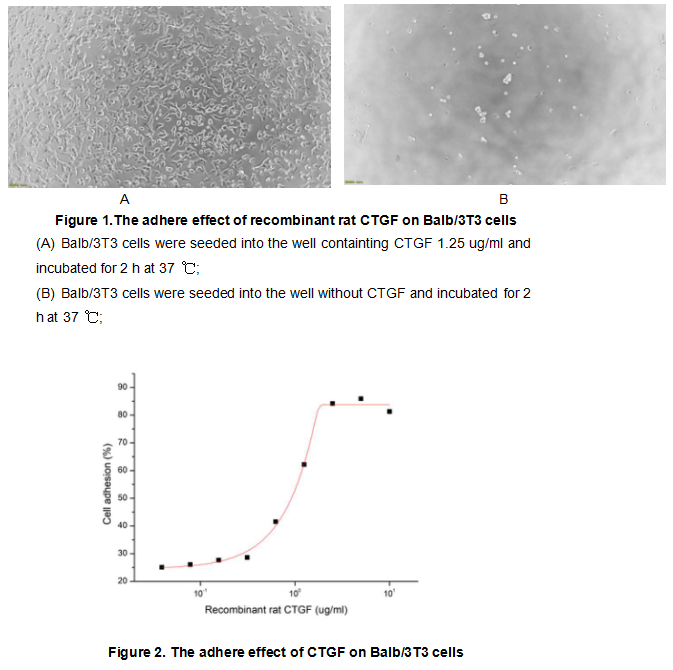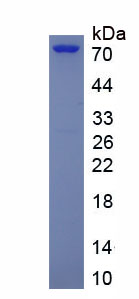Active Connective Tissue Growth Factor (CTGF) 

CCN2; HCS24; IGFBP8; NOV2; Insulin-Like Growth Factor-Binding Protein 8; Hypertrophic Chondrocyte-Specific Protein 24; CCN Family Member 2
Overview
Properties
- Product No.APA010Ra01
- Organism SpeciesRattus norvegicus (Rat) Same name, Different species.
- ApplicationsCell culture; Activity Assays.
Research use only - DownloadInstruction Manual
- CategoryCytokine
- Buffer FormulationPBS, pH7.4, containing 0.01% SKL, 5% Trehalose.
- Traits Freeze-dried powder, Purity > 90%
- Isoelectric Point8.2
Sign into your account
Share a new citation as an author
Upload your experimental result
Review

Contact us
Please fill in the blank.
Activity test



Connective Tissue Growth Factor (CTGF), also known as CCN2 is a matricellular protein of the CCN family of extracellular matrix-associated heparin-binding proteins. CTGF has important roles in many biological processes, including cell adhesion, migration, proliferation, angiogenesis, skeletal development, and tissue wound repair, and is critically involved in fibrotic disease and several forms of cancers. As CTGF has the function of cell adhesion, we measure the activity of recombinant rat CTGF by the ability of the immobilized protein to support the adhesion of Balb/3T3 mouse embryonic fibroblast cell. When 5 x 104 cells/well are added to different concentrations of recombinat rat CTGF coated plates, cells will adhere after 2 hour incubation at 37 ℃. The adhesion of Balb/3T3 after 2 hour incubation at 37 ℃ observed by inverted microscope was shown in Figure 1. Cell adherent was in a dose dependent manner, the result was shown in Figure 2, the EC50 was 1 ug/ml.
Usage
Reconstitute in 10mM PBS (pH7.4) to a concentration of 0.1-1.0 mg/mL. Do not vortex.
Storage
Avoid repeated freeze/thaw cycles. Store at 2-8°C for one month. Aliquot and store at -80°C for 12 months.
Stability
The thermal stability is described by the loss rate. The loss rate was determined by accelerated thermal degradation test, that is, incubate the protein at 37°C for 48h, and no obvious degradation and precipitation were observed. The loss rate is less than 5% within the expiration date under appropriate storage condition.
Increment services
-
 BCA Protein Quantification Kit
BCA Protein Quantification Kit
-
 Molecular Mass Marker for Protein
Molecular Mass Marker for Protein
-
 Monoclonal Antibody Customized Service
Monoclonal Antibody Customized Service
-
 Polyclonal Antibody Customized Service
Polyclonal Antibody Customized Service
-
 Protein Activity Test Experiment Service
Protein Activity Test Experiment Service
-
 Electrophoretic Mobility Shift Assay (EMSA) Experiment Service
Electrophoretic Mobility Shift Assay (EMSA) Experiment Service
-
 Buffer
Buffer
-
 Lentivirus Packaging Experiment Service
Lentivirus Packaging Experiment Service
-
 Adenovirus Packaging Experiment Service
Adenovirus Packaging Experiment Service
-
 Real Time PCR Experimental Service
Real Time PCR Experimental Service
-
 Spike RBD Protein (S-RBD)
Spike RBD Protein (S-RBD)
-
 Protein G
Protein G
-
 Protein A
Protein A
Citations
- Promotion of bone formation by naringin in a titanium particle-induced diabetic murine calvarial osteolysis modelPubMed: 19824055
- Connective tissue growth factor hammerhead ribozyme attenuates human hepatic stellate cell functionPubMed: PMC2726461
- Activation of JNK Signaling Mediates Connective Tissue Growth Factor Expression and Scar Formation in Corneal Wound HealingPlosone: 0032128
- Clinical significance of inflammatory and fibrogenic cytokines in diabetic nephropathyScienceDirect: S0009912012000987
- Connective tissue growth factor (CTGF/CCN2): A protagonist in cardiac allograft vasculopathy development?PubMed: S1053249812010121
- The Intervention Effect of Rosiglitozone in Ovarian Fibrosis of PCOS RatsBesjournal: Source
- Concentrations of connective tissue growth factor in patients with nonalcoholic fatty liver disease: Association with liver fibrosisPubMed: 22846210
- Clinical significance of connective tissue growth factor in hepatitis B virus-induced hepatic fibrosisPubMed: PMC3351780
- Multitargeted protective effect of Abacopteris penangiana against carrageenan-induced chronic prostatitis in rats.Pubmed: 24211397
- Cytokine levels as biomarkers of radiation fibrosis in patients treated with breast radiotherapyRo-journal: Source
- Knock Out of S1P3 Receptor Signaling Attenuates Inflammation and Fibrosis in Bleomycin-Induced Lung Injury Mice ModelPubmed:Pmc4157792
- Connective tissue growth factor and cardiac diastolic dysfunction: human data from the Taiwan Diastolic Heart Failure Registry and molecular basis by cellular and animal modelsPubmed:24464932
- Connective Tissue Growth Factor is a Target of Notch Signaling in Cells of the Osteoblastic LineagePubmed:24792956
- Disruption of collagen homeostasis can reverse established age-related myocardial fibrosisPubmed:25701883
- Beneficial effects of combined ursodeoxycholic acid and angiotensin-II type 1 receptor blocker on hepatic fibrogenesis in a rat model of nonalcoholic steatohepatitisPubMed: 26190501
- Suppression of connective tissue growth factor mediates the renoprotective effect of Sitagliptin rather than Pioglitazone in type 2 diabetes mellitusPubmed:27049870
- TGF-β and Physiological Root Resorption of Deciduous Teeth.pubmed:28035998
- Fibrosis of extracellular matrix is related to the duration of the disease but is unrelated to the dynamics of collagen metabolism in dilated cardiomyopathypubmed:27516211
- Left ventricular reverse remodeling is not related to biopsy-detected extracellular matrix fibrosis and serum markers of fibrosis in dilated cardiomyopathy, regardless of the definition used for LVRRpubmed:28004175
- The relationship between anti-vascular endothelial growth factor and fibrosis in proliferative retinopathy: clinical and laboratory evidencepubmed:27531356
- Molecular mechanisms underlying fibrosis and elastin destruction in childhood interstitial lung diseasespubmed:27686729
- Cardioprotection against Heart Failure by Shenfu Injection via TGF-β/Smads Signaling Pathwaypubmed:28698735
- Left ventricular reverse remodeling is not related to biopsy‑detected extracellular matrix fibrosis and serum markers of fibrosis in dilated cardiomyopathy, regardless of the definition used for LVRR10.1007/s00380-016-0930-y
- 12-month patterns of serum markers of collagen synthesis, transforming growth factor and connective tissue growth factor are similar in new-onset and chronic dilated cardiomyopathy in patients both with and without cardiac fibrosis.pubmed:28460256
- Prognostic value of fibrosis-related markers in dilated cardiomyopathy: A link between osteopontin and cardiovascular events.pubmed:29120858
- Sustained β-AR stimulation induces synthesis and secretion of growth factors in cardiac myocytes that affect on cardiac fibroblast activationPubmed:29107793
- Substrate Stiffness Influences the Time Dependence of CTGF Protein Expression in Müller CellsPubmed:30123889
- TGFβ mediates collagen production in human CRSsNP nasal mucosa‐derived fibroblasts through Smad2/3‐dependent pathway and CTGF induction and secretionPubmed: 30426494
- Combination of Plasma Biomarkers and Clinical Data for the Detection of Myocardial Fibrosis or Aggravation of Heart Failure Symptoms in Heart Failure with …Pubmed: 30413105
- Macrophage hypoxia signaling regulates cardiac fibrosis via Oncostatin MPubmed: 31249305
- Circulating Connective Tissue Growth Factor Is Associated with Diastolic Dysfunction in Patients with Diastolic Heart FailurePubmed: 31466059
- CTGF Attenuates Tendon-Derived Stem/Progenitor Cell AgingPubmed: 31827530
- Small-Dose Sunitinib Modulates p53, Bcl-2, STAT3, and ERK1/2 Pathways and Protects against Adenine-Induced NephrotoxicityPubmed: 33212804
- Lysophosphatidic acid as a regulator of endometrial connective tissue growth factor and prostaglandin secretion during estrous cycle and endometrosis in the …Pubmed: 32943074
- MicroRNAs and ventricular remodeling in aortic stenosisPubmed: 32682570
- Manuscript title Microparticles Containing MiR-625-5p In Coronary Artery Reduce Myocardial Fibrosis After Myocardial Infarction
- High carbohydrate high fat diet causes arterial hypertension and histological changes in the aortic wall in aged rats: The involvement of connective tissue growth …34455071
- Hepatocyte-specific Smad4 deficiency alleviates liver fibrosis via the p38/p65 pathway









